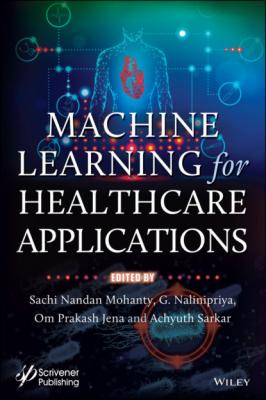ТОП просматриваемых книг сайта:















Machine Learning for Healthcare Applications. Группа авторов
Читать онлайн.Название Machine Learning for Healthcare Applications
Год выпуска 0
isbn 9781119792598
Автор произведения Группа авторов
Жанр Программы
Издательство John Wiley & Sons Limited
Table 2.4 Recall of the model.
| Health status | Model 1 | Model 2 | ||
|---|---|---|---|---|
| Recall:Phase-I | Recall:Phase-II | Recall:Phase-I | Recall:Phase-II | |
| Sleep | 93.4782609 | 94.7368421 | 94.5652174 | 95.8333333 |
| Smoke | 95.6989247 | 97.8723404 | 97.8723404 | 97.8947368 |
| Drink | 93.4782609 | 96.8421053 | 97.8947368 | 98.9473684 |
| Screen | 95.6521739 | 95.7894737 | 95.7446809 | 97.8723404 |
| Calories | 95.78941737 | 98.9583333 | 96.8085106 | 98.9690722 |
Figure 2.5 Recall: Model-I vs Model-II.
Table 2.4 shows the Recall comparison between the model-1 and model-2.
Figure 2.5 shows the Recall comparison between the two models which are proposed in this chapter and it is observed the model-II gives more accuracy than the model-I.
2.5.1.4 F1-Score
The F1-score is the harmonic mean of precision and recall. Below equation used to calculate the F1-score.
Figure 2.6 shows the F1-score comparison between the two models which are proposed in this chapter and it is observed the model-II gives more accuracy than the model-I. Table 2.5 shows the F1-Score comparison between the model-1 and model-2.
Table 2.5 F1-score of the model.
| Health status | Model 1 | Model 2 | ||
|---|---|---|---|---|
| F1-score:Phase-I | F1-score:Phase-II | F1-score:Phase-I | F1-score:Phase-II | |
| Sleep | 94.50549 | 96.25668 | 95.08197 | 96.84211 |
| Smoke | 95.69892 | 96.84211 | 96.84211 | 97.89474 |
| Drink | 94.50549 | 97.3545 | 97.89474 | 98.94737 |
| Screen | 96.17486 | 96.80851 | 96.77419 | 97.3545 |
| Calories | 96.80851 | 98.4456 | 97.3262 | 98.96907 |
Figure 2.6 Recall: Model-I vs Model-II.
2.6 Conclusion
In this chapter, we have proposed an architecture based on machine learning algorithms. Basically, we focus on a challenging problem of predicting the overall health status of an individual based on their daily life activities and measures. The proposed system predicts the overall health status of a person and future diseases using machine learning techniques. To demonstrate the proposed model, we have created a web-based application. The proposed model helps the user to understand their health status by submitting their details. For training and testing we used the synthetic data, in the future we need to test the proposed model using the real data by collecting from the users. In this work, we attempted a general healthcare problem and a lot more has to be done in the future. The future work is to predict the diseases based on the overall health status estimation using the models proposed in this chapter.
References
1. Bjartveit, K. and Tverdal, A., Health consequences of smoking 1–4 cigarettes per day. Tobacco Control, 14, 5, 315–320, 2005.
2. Weng, C.-H., Huang, T.C.-K., Han, R.-P., Disease prediction with different types of neural network classifiers. Telematics Inf., 33, 2, 277–292, 2016.
3. Alpaydın, E., Introduction to Machine Learning, 2nd edition, the MIT press, Cambridge, Massachusetts, 2010.
4. Harris, J.A. and Benedict, F.G., A Biometric Study of Human Basal Metabolism. Proc. Natl. Acad. Sci. U.S.A., 4, 12, 370–373, 1918.
5. Hirshkowitz, M., Whiton, K., Albert, S.M., Alessi, C., Bruni, O., DonCarlos, L., Hillard, P.J.A., National Sleep Foundation’s sleep time duration recommendations: Methodology and results summary. Sleep Health, 1, 1, 40–43, 2015.
6. Hung, C.-Y., Chen, W.-C., Lai, P.-T., Lin, C.-H., Lee, C.-C., Comparing deep neural network and other machine learning algorithms for stroke

